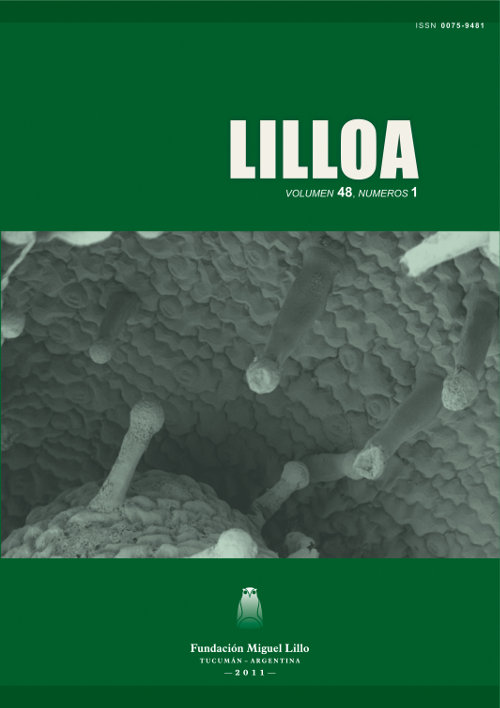Flourensia fiebrigii (Asterales: Asteraceae), source of antipathogenic metabolites
Keywords:
Biofilms, Biomphalaria peregrina, extracts, Flourensia fiebrigii, anti-pathogenic activity, spectroscopy, Staphylococcus aureusAbstract
Verni, Cecilia; Alva, Mariana; Muruaga, Nora; Borkosky, Susana; Car tagena, Elena; Bardón, Alicia. 2011. “Flourensia fiebrigii (Asterales: Asteraceae), source of antipathogenic metabolites”. Lilloa 48 (1). This paper deals with the spectroscopic study of extracts from the shrub Flourensia fiebrigii and its activity against mature biofilm of two pathogenic bacteria. We employed an international collection of Staphylococcus aureus strain and a methicillin-resistant S. aureus strain. In order to propose anti-pathogenic metabolites of low toxicity to freshwater species, we determined the activity of the extracts against the snail Biomphalaria peregrina. The UV, FT-IR, 1H-NMR and 13C spectroscopic studies of the extracts from the aerial parts of F. fiebrigii revealed the presence of prenylated flavonoids. The dewaxed CHCl3 extract showed the highest biofilm disrupting activity at 50 µg/mL against the methicillin-resistant strain (65%), while the crude CHCl3 extract showed a 60% of reduction at 100 µg/mL. The active extract doses against the pathogenic S. aureus strains resulted not toxic to B. peregrina.
Downloads
References
Adwan, G. & M. Mhanna. 2008. Synergistic effects of plants extracts and antibiotics on Staphylococcus aureus strains isolated from clinical specimens. Middle-East Journal of Scientific Research, 3: 134-139.
Bohlmann, F. & M. Grenz.1977. Über Inhaltsstoffe der Gattung Flourensia. Chemische Berichte, 110: 295-300.
Bohlmann, F. & J. Jakupovic.1979. Neue sesquiterpene, triterpene, flavanone und andere Aromatische
Verbindungen aus Flourensia heterolepis. Phytochemistry, 18: 1189-1194.
Bohlmann, F.; J. Jakupovic; A. Schuster; R.M. King & H. Robinson. 1984. Eudesmanolides and costic acid derivatives from Flourensia macrophylla. Phytochemistry, 23: 1445-1448.
Cabrera, A. L. 1978. Compositae. En A. L. Cabrera (ed), Fl. Prov. Jujuy, Colecc. Ci. Inst. Nac. Tecnol. Agrpopecu., 13 (10): 1-726.
Cartagena, E.; O. Álvarez Colom; A. Neske; J. C. Valdez & A. Bardón. 2007. Effects of plant lactones on the production of biofilm of Pseudomonas aeruginosa. Chemical and Pharmaceutical Bulletin, 55: 22-25.
Diaz Garces,R. & J. R. Ferrer Lopez. 1996. Efecto de las dosis letales de las plantas de la família Agavaceae sobre la actividad cardíaca y la oviposición de Biomphalaria havanensis (Mollusca: Planorbidae). Revista Cubana de Medicina Tropical, 48: 15-20.
Dillon, M. O. 1984. A Systematic Study of Flourensia (Asteraceae-Heliantheae), Fieldiana Bot., 16: 1-66.
Femenía, J. H. 2009. Flora del Famatina. Diario chilecito.com (inédito).
García, M.; A. González Coloma; O. J. Donadel; C. E. Ardanaz; C. E. Tonn & M. E. Sosa. 2007. Insecticidal effects of Flourensia oolepis Blake (Asteraceae) essential oil. Biochemical Systematic and Ecology, 35: 181-187.
Gilabert, M.; A. N. Ramos; M. M. Schiavone; M. E. Arena & A. Bardón. 2011. Bioactive sesqui- and diterpenoids from the Argentine Liverwort Porella chilensis. Journal of Natural Products, 74 (4): 574-579.
Godin, P. 1954. A new spray reagent for paper chromatography of polyols and cetoses. Nature, 174: 134.
Harborne, J. B.1998. Flavonoids. In Phytochemical methods. A guide to modern techniques of plant analysis.Third edition. Chapman & Hall. London p. 60.
Marchant, Y.; F. Balza; B. F. Abeysekera & G. H. N. Towers. 1984. Molluscicidal activity of sesquiterpene lactones. Biochemical Systematic & Ecology, 12: 285-286.
Monroe, D. 2007. Looking for chinks in the armor of bacterial biofilms. PLoS Biology, 5: 2458-2461.
Mott, K. E. (1987). Plant Molluscicides. John Wiley, Chichester.
O’Toole, G. A. & R. Kolter. 1998. Initiation of biofilm formation in Pseudomonas fluorescens WCS365 proceeds via multiple, convergent signalling pathways: a genetic analysis. Molecular Microbiology, 28: 449-461.
Parellada, E. A.; A. N. Ramos; M. Ferrero; E. Cartagena; A. Bardón; J. C. Valdez & A. Neske. 2011. Squamocin mode of action to stimulate biofilm formation of Pseudomonas plecoglossicida J26, a PAHs degrading bacterium. International Biodeterioration & Biodegradation, 65: 1066-1072.
Rittschof, D. & P. McClellan-Green. 2005. Mollusks as multidisciplinary models in environmental toxicology. Marine Pollution Bulletin, 50: 369-373.
Silva, M. & A. Scopel. 2005. Flourensia oolepis S. F. Blake y F. campestris Griseb. (Asteraceae): Estudios preliminares en la sierras de Córdoba. Bol. Soc. Argent. Bot., 40: 107-108.
Socolsky, C.; E. Cartagena; Y. Asakawa & A. Bardón. 2011. Acylphloroglucinols from the fern Elaphoglossum lindbergii. ARKIVOC, 7: 450-460.
Taylor, P. W.; P. D. Stapleton & J. P. Luzio. 2002. New ways to treat bacterial infections Drug Discovery Today, 7: 1086-1091.
Uriburu, M. L.; J. R. de la Fuente; J. Palermo; R. R. Gil & V. E. Sosa. 2004. Constituents of two Flourensia species. Phytochemistry, 65: 2039-2043.
Uriburu, M. L.; J. R. de la Fuente; J. Palermo & V. E. Sosa. 2005. A Chlorinated dihydrobenzofuran from Flourensia riparia. Journal of Argentine Chemical Society, 93: 161-164.
Uriburu, M. L.; R. R. Gil; V. E. Sosa & J. R.de la Fuente. 2007. Prenylflavonoids from Flourensia fiebrigii. Phytochemistry, 68: 1295-1299.
Valdez, J. C.; M. C. Peral; M. Rachid; M. Santana & G. Perdigón. 2005. Interference of Lactobacillus plantarum with Pseudomonas aeruginosa in vitro and in infected burns: the potential use of probiotics in wound treatment. European Society of Clinical Microbiology and Infectious Diseases, 11: 472-479.
WHO. 1983. Reports of the scientific working group on plants molluscicides. Document TDR/SCH.SWG/4/83.3. Geneva: World Health Organization.
Wink, M. 1999. Introduction: biochemistry, role and biotechnology of secondary metabolites. In Functions of Plant Secondary Metabolites and Their Exploitation in Biotechnology. Wink, M. Sheffield Academic Press, England pp. 1-16.






